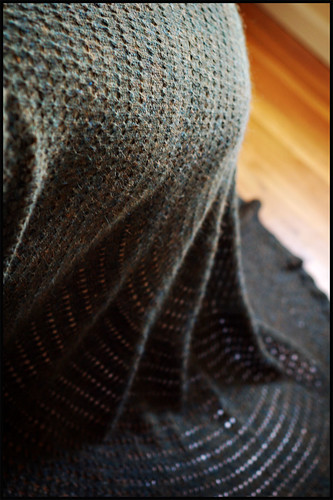
Pattern: The Pi Shawl by Elizabeth Zimmermann (on ravelry)
Source: Knitter's Almanac (July)
Materials: Ístex Plötulopi Unspun Icelandic Wool; just uner 6 wheels (1800 yards)*
Needles: 36-Inch US 8/5.0 mm Addi Turbo Circulars
Dimensions: 78" diameter after blocking; 64" diameter unblocked
*See bottom of post for additional details on yarn and blocking
Start Date: 19 October 2007
Finish Date: 9 January 2008
Source: Knitter's Almanac (July)
Materials: Ístex Plötulopi Unspun Icelandic Wool; just uner 6 wheels (1800 yards)*
Needles: 36-Inch US 8/5.0 mm Addi Turbo Circulars
Dimensions: 78" diameter after blocking; 64" diameter unblocked
*See bottom of post for additional details on yarn and blocking
Start Date: 19 October 2007
Finish Date: 9 January 2008
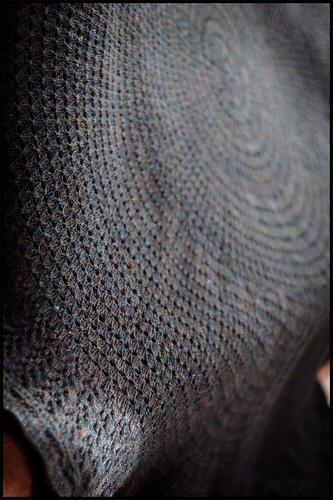
Notes on the pattern: Of all the many genius ideas of Elizabeth's, to me, the Pi Shawl is one of the most mind-blowing. If you aren't familiar with the pattern I urge you to read it, for the pure enjoyment of how clever it is in all its glorious simplicity. Worked from the center out, the entire piece has no more than 6 (or 7 in my case) increase rounds total - meaning 99% of this shawl is straight knitting (save whatever lacey embellishments you'd like to incorporate) which gets major points in my book.
The other beautiful thing about the Pi Shawl is its endless potential for individuality. Spend a little time trolling the web for completed Pi Shawls (there are hundreds) and you'll see what I mean. The beauty of the pattern is it's blank-canvas-like nature - consecutive rings of set stitch counts (144, 288, 576, etc.) which just beg you to plug in any old lace motif that's giving you an itch.
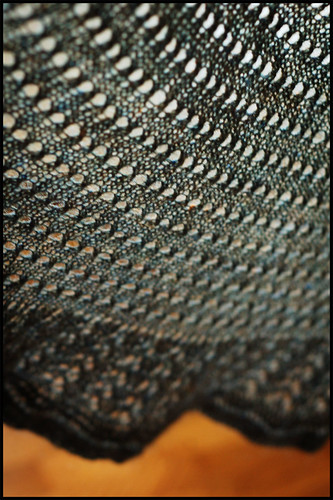
If you aren't feeling all that creative, or have your heart set on one of the versions EZ suggests (like I did) - that's just fine too. There are two beauties already laid out for you in both Knitter's Almanac and Knitting Workshop. I have always loved the straight forward and classic beauty of the 'consecutive YO ring' version and knew that I wanted to give it a go. This is basically a stockinette circular shawl with a *YO, k2tog* round thrown in every 6th row. I love how these "sham rows" completely camouflage the actual organic increase rounds. The shaping is invisible in the entourage of lace rings. So great!
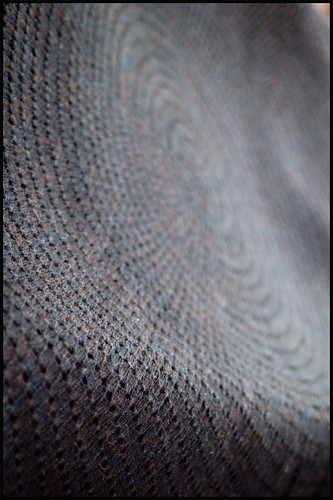
Elizabeth talks about how there is never a need to increase beyond the 576 stitch section, as the shawl will already be nice and big (she says something about not having a need to cover a football field?). I had a lot of yarn though, and really wanted to see how far I could push this, with the ultimate goal of having a big blanket for the couch. My calculations showed that I would have enough wool for about 22 rows into the 1152 stitch section (oh the horror), plus an attached (9-stitch) garter side-to-side edging.
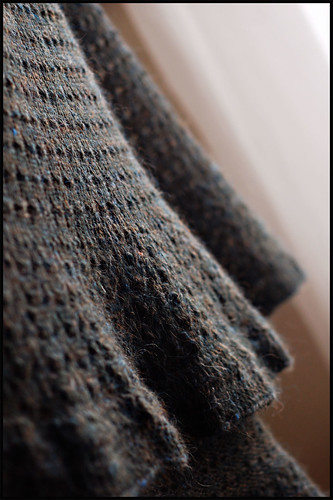
The most miraculous part of the whole process is probably that I was able to keep a treacherous number of stitches on a 36" circular needle. It got a little rough on my hands towards the end, but when that frantic finishing fever comes over you just about nothing can stand in your way, right? Having a huge round of knitting on a circular needle also makes it impossible to predict just how big the piece will be. Before working the edging, you have nothing more than a big rumpled sack of holey wool sitting in your lap that looks more like an oversized rasta cap than a lace blanket. Some days it took all my control to keep from bucking my calculations and indulging in the bind-off, just to be able to free the lace from the needles.
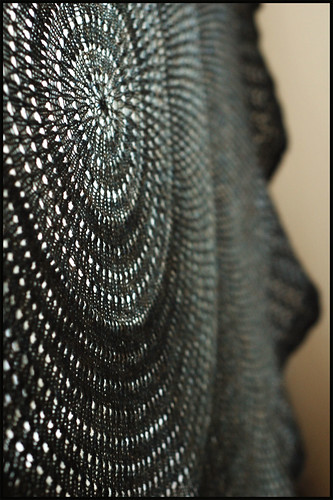
The edging of the shawl is the only section that got a little bit of fancy lace (not that fancy, but relatively). I think a little hint of laciness around the edge makes the simpler ring pattern really shine. After my final increase round I switched into a gull stitch pattern and worked 5 vertical repeats around before starting the attached garter stitch edging aaaaall the way around.
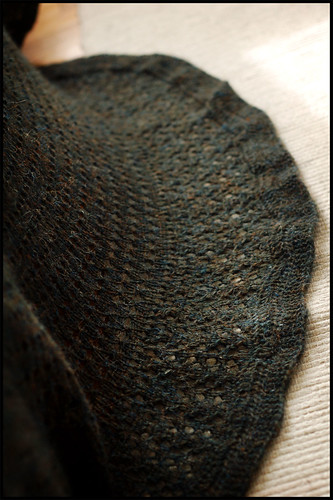
Some notes on yarn: Unspun Icelandic is a wonderful, wonderful thing. If you're a fan of wooly things, you must get your hands on some (I received mine as a gift from a friend in Iceland, but you can purchase it online through Schoolhouse Press). Don't get me wrong, this isn't a yarn you're gonna want around your neck - it's a far cry from merino - but it has its own unique qualities that I could go on and on about. First of all, because it's an unspun, long-stapled wool, it's as light as air and very warm. Even in a thin piece of lace full of holes, it works surprisingly well at trapping warmth. The blanket is huge and light and toasty -exactly the combination I was looking for. The other benefit is the yardage. Each wheel seems to go on and on and on - I made a blanket that covers a queen sized bed with less than 6 wheels of the stuff (it's about 300 yards to 3.5 oz) on a US 8.
And if you fear knitting with something so "delicate", you can get rid of that idea straight away. The wool staple is longer than the distance between your needle and your fingers, so while knitting it feels just like any other yarn, and if it does break coming out of the skein (rarely happened, unaided by dogs or human feet) it's no problem. The yarn sticks to itself like velcro - so to join a break just overlap about 2 inches on each end and knit right past it. That's the other bonus - no ends to weave in, and no spit splicing necessary. It's like knitting an 1800 yard cone - carefree and seamless. And to dispell any rumours, the knitted fabric is just as strong as any other yarn out there on the market.
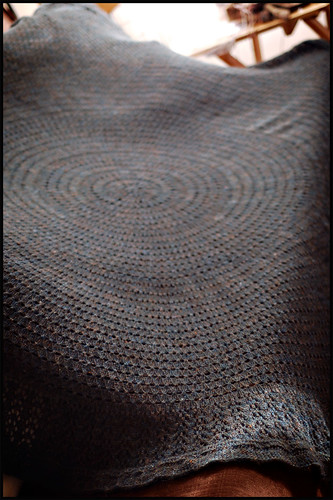
I guess this counts as my first official finished knit of 2008. It's already taken some serious self-control to keep myself from purchasing more of this wool (the natural colors are amazing) and cast on for another. It became an immediate crowd-pleaser in my home, so another one might not be such a bad idea.
Edited to Add: The following information has been added to the post in response to questions I've received via e-mail about this project. I hope they are helpful.
First, more specifics about the color of the wool. I received this yarn as a gift from a friend in Iceland. She purchased the yarn there in person. Schoolhouse Press does sell this yarn, but in a limited palette - which I should have mentioned earlier - and does not currently carry the color that I used.
The color of my wool is titled Sea Green Heather and listed as product #1422 on the Istex official color card - viewable here. You'll notice they have a lot of wonderful colors! Don't say I didn't warn you.
In researching, we think that the best bet for possibly acquiring this yarn by mail order would be the Handknitting Association of Iceland, but can't say for sure. All of their contact information is available behind the link. NOTE: it seems that the colorcard listed on their site is an older version and sites Sea Green Heather as #9736.
Blocking: Yes, blocking was quite a challenge in our hardwood-floored, tiny apartment. I was hoping to be able to block the shawl on the queen-sized bed but realized very soon that this would not be possible. After some creative brainstorming, we tried a rather unconventional but nonetheless effective way of blocking - involving the box spring. The picture says it all.
And finally - a few of you asked if I worked with the unspun Icelandic wool single stranded or held it double stranded. I worked single stranded.


